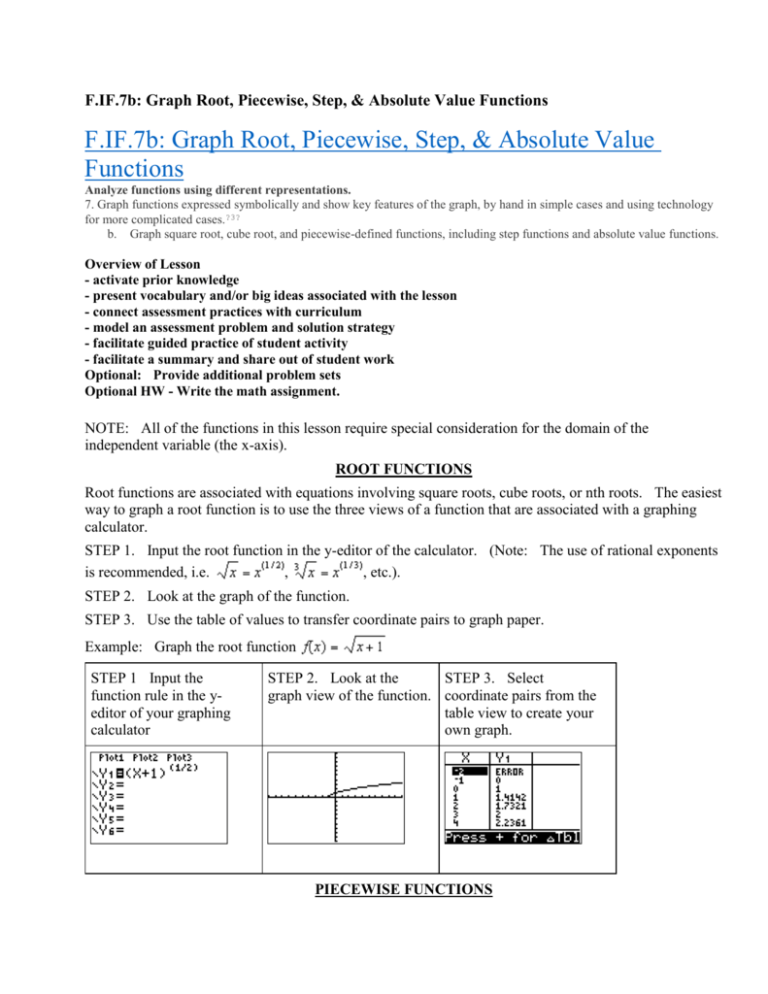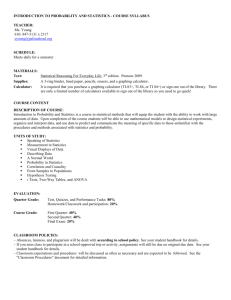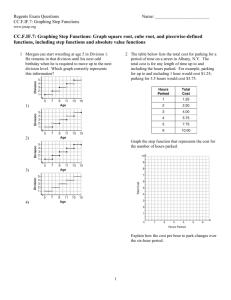DOC - JMap
advertisement

F.IF.7b: Graph Root, Piecewise, Step, & Absolute Value Functions F.IF.7b: Graph Root, Piecewise, Step, & Absolute Value Functions Analyze functions using different representations. 7. Graph functions expressed symbolically and show key features of the graph, by hand in simple cases and using technology for more complicated cases.?3? b. Graph square root, cube root, and piecewise-defined functions, including step functions and absolute value functions. Overview of Lesson - activate prior knowledge - present vocabulary and/or big ideas associated with the lesson - connect assessment practices with curriculum - model an assessment problem and solution strategy - facilitate guided practice of student activity - facilitate a summary and share out of student work Optional: Provide additional problem sets Optional HW - Write the math assignment. NOTE: All of the functions in this lesson require special consideration for the domain of the independent variable (the x-axis). ROOT FUNCTIONS Root functions are associated with equations involving square roots, cube roots, or nth roots. The easiest way to graph a root function is to use the three views of a function that are associated with a graphing calculator. STEP 1. Input the root function in the y-editor of the calculator. (Note: The use of rational exponents is recommended, i.e. , , etc.). STEP 2. Look at the graph of the function. STEP 3. Use the table of values to transfer coordinate pairs to graph paper. Example: Graph the root function STEP 1 Input the function rule in the yeditor of your graphing calculator STEP 2. Look at the STEP 3. Select graph view of the function. coordinate pairs from the table view to create your own graph. PIECEWISE FUNCTIONS A piecewise function is a function that is defined by two or more sub functions, with each sub function applying to a certain interval on the x-axis. Each sub function may also be referred to as a piece of the overall piecewise function, hence the name piecewise. Example. The following is a piecewise function: This example of a piecewise function has two “pieces,” or sub functions. a. Over the interval 3 x 1, the sub function is b. Over the interval 1 x 7, the sub function is . A table of values for this function might look like this, reflecting two pieces. x x -3 -5 na 3 na 4 -2 -3 na 4 na 4 -1 -1 na 5 na 4 0 1 na 6 na 4 4 7 na 4 4 8 na na 1 2 na Continuity Piecewise functions are often discontinuous, which means that the graph will not appear as a single line. In the above table, the piecewise function is discontinuous when . This is because is not included in the first piece of the piecewise function. Because piecewise functions are often discontinuous, care must be taken to use proper inequalities notation when graphing. Using Line Segments to Define Pieces If the circle at the beginning or end of a solution set (graph) is empty, that value is not included in the solution set. If the circle is filled in, that value is included in the solution set. -3 The number 1 is not included in the this solution set: -2 The number 1 is included in this following solution set: The graph of appears below: 0 1 2 3 Lesser Greater -3 The graph of this piecewise function looks like this: -1 Lesser -2 -1 0 1 2 3 Greater Y-Axis 1 2 3 4 5 -1 6 X-Axis 7 -2 -3 -4 -5 STEP FUNCTIONS A step function is typically a piecewise function with many pieces that resemble stair steps. Each step correspondends to a specific domain. The function rule for the graph above is: ABSOLUTE VALUE FUNCTIONS Using a Graphing Calculator To Solve and Graph Absolute Value Functions: Absolute value functions may be solved in a graphing calculator by moving all terms to one side of the inequality and reducing the other side to zero. The inequality is then entered into the graphing calculator’s Y feature. Once input, the calculator’s 2nd TABLE and GRAPH features may be accessed and manipulated using the ( 2nd TBL SET ) and graph WINDOW features. Example: Given : x 1 3 6 First, move everything to one side of the inequality, leaving the other side zero. Y= Input Pay particular attention to setting the inequality sign on the far left of the input screen. Graph x 1 3 6 x 1 9 0 or 0 x 1 9 NOTE: The abs entry is found in the graphing calculator’s catalog. You can see from the graph that the solution boundaries are 10 and 8 . Test x 0 to confirm the answers x 10 and x 8 , which are the parts of the graph that lie above the x-axis. Typically, you would graph only the xaxis on the Regents Math B Exam. Table of Values NOTE: The table of values in the graphing calculator provides an excellent opportunity to reinforce the idea that absolute values cannot have negative values. Any value of x that results in a negative value of y cannot be part of the solution set of an absolute value inequality. NOTE: The table of values in the graphing calculator provides an excellent opportunity to reinforce the idea that absolute values cannot have negative values. REGENTS PROBLEMS 1. A function is graphed on the set of axes below. Which function is related to the graph? a. c. b. d. 2. Graph the following function on the set of axes below. 3. On the set of axes below, graph the function . State the range of the function. State the domain over which the function is increasing. 4. On the set of axes below, graph the function represented by 5. Draw the graph of on the set of axes below. for the domain . 6. Which graph represents ? a. c. b. d. 7. At an office supply store, if a customer purchases fewer than 10 pencils, the cost of each pencil is $1.75. If a customer purchases 10 or more pencils, the cost of each pencil is $1.25. Let c be a function for which is the cost of purchasing x pencils, where x is a whole number. Create a graph of c on the axes below. A customer brings 8 pencils to the cashier. The cashier suggests that the total cost to purchase 10 pencils would be less expensive. State whether the cashier is correct or incorrect. Justify your answer. 8. Morgan can start wrestling at age 5 in Division 1. He remains in that division until his next odd birthday when he is required to move up to the next division level. Which graph correctly represents this information? a. c. b. d. 9. The table below lists the total cost for parking for a period of time on a street in Albany, N.Y. The total cost is for any length of time up to and including the hours parked. For example, parking for up to and including 1 hour would cost $1.25; parking for 3.5 hours would cost $5.75. Graph the step function that represents the cost for the number of hours parked. Explain how the cost per hour to park changes over the six-hour period. F.IF.7b: Graph Root, Piecewise, Step, & Absolute Value Functions Answer Section 1. ANS: B Strategy: Since is included in every answer choice, concentrate on the linear functions for The linear equation has a slope of . The only linear function that has a slope of . is , which is answer choice b. PTS: 2 2. ANS: REF: 081422a1 NAT: F.IF.7b TOP: Graphing Piecewise-Defined Functions Strategy: Use a graphing calculator and graph the function in sections, paying careful attention to open and closed circles at the end of each function segment. STEP 1. Graph over the interval . Use a closed dot for Use data from the table of values to plot the interval STEP 2: Graph over the interval and an open dot for . . . Use a closed dot for Use data from the table of values to plot the interval and a closed dot for . . Do not connect the two graph segments. PTS: 2 3. ANS: REF: 011530a1 NAT: F.IF.7b TOP: Graphing Piecewise-Defined Functions The range is . The function is increasing for . Strategy: Input the function in a graphing calculator and use the table and graph views to complete the graph on paper and to answer the questions. PTS: 4 4. ANS: REF: fall1310a1 NAT: F.IF.7b TOP: Graphing Absolute Value Functions Strategy: Input the function in a graphing calculator, then use the graph and table views to construct the graph on paper. Limit the domain of the graph to . STEP 1: Use exponential notation to input the function into the graphing calculator, where Then use the table and graph views to reproduce the graph on paper. . STEP 2: Limit the domain of the function to coordinates (-6, -2) and for (10, 2). PTS: 2 5. ANS: REF: fall1304a1 . Used closed dots to show the ends of the function at NAT: F.IF.7b TOP: Graphing Root Functions Strategy: Input the function in a graphing calculator, then use the graph and table views to construct the graph on paper. STEP 1: Use exponential notation to input the function into the graphing calculator, where Then use the table and graph views to reproduce the graph on paper. . Note: Do nopt plot coordinates with errors. Focus on plotting coordinates with integer values and estimate the graph between the points with integer values when drawing the graph. STEP 2: Limit the domain of the function to coordinates (-6, -2) and for (10, 2). . Used closed dots to show the ends of the function at PTS: 2 REF: 061425a1 6. ANS: B Strategy: Eliminate wrong answers. NAT: F.IF.7b TOP: Graphing Root Functions The left half of each graph corresonds to over the domain . The graph of should not curve because x is of the first degree. Answer choices c and d should be eliminated because they have curves over the domain . A quick look at the graph of in a graphing calculator shows why answer choices c and d should be eliminated. The graph of over the domain A quick look at the graph of PTS: 2 REF: 081516ai KEY: bimodalgraph 7. ANS: should be not be a straight line because the degree of x is not 1. in a graphing calculator shows that answer choice b is correct. NAT: F.IF.7 TOP: Graphing Piecewise-Defined Functions he cashier is correct. 8 pencils cost $14 and 10 pencils cost $12.50. Strategy: Use a graphing calculator and graph the function in two sections. Note that the domain of the function is whole numbers. You cannot buy a part of a pencil. This means that the graph of the function will consist of points and not lines. After completing the graph, answer the questions presented in the problem. STEP 1: Graph the section of the function represented by in the domain . . Plot closed dots for each whole number STEP 2: Graph the section of the function represented by in the domain . . Plot closed dots for each whole number STEP 3: Answer the questions presented in the problem. The data tables and the graph show that it would be cheaper to purchase 10 pencils that to purchase 8 pencils. PTS: 4 REF: fall1312a1 NAT: F.IF.7b TOP: Graphing Piecewise-Defined Functions 8. ANS: A Strategy: Focus on whether the line segments should begin and end with closed or open circles. A closed circle is included. An open circle is not included. PTS: 2 REF: 061507AI KEY: bimodalgraph 9. ANS: NAT: F.IF.7b TOP: Graphing Step Functions The cost per houir to park gets bigger over the six hour period. Strategy: Graph this step function by hand using information from the table. This function has too many sections to easily input into a graphing calculator. STEP 1. Graph the section for the domain . The table shows that this interval corresponds to a cost of $1.25 on the y-axis. Use an open dot at (0, 1.25) and a closed dot at (1, 1.25). Connect the two dots with a solid line. STEP 2. Graph the section for the domain . The table shows that this interval corresponds to a cost of $2.50 on the y-axis. Use an open dot at (1, 2.50) and a closed dot at (2, 2.50). Connect the two dots with a solid line. STEP 3. Graph the section for the domain . The table shows that this interval corresponds to a cost of $4.00 on the y-axis. Use an open dot at (2, 4.00) and a closed dot at (3, 4.00). Connect the two dots with a solid line. STEP 4. Graph the section for the domain . The table shows that this interval corresponds to a cost of $5.75 on the y-axis. Use an open dot at (3, 4.75) and a closed dot at (4, 4.75). Connect the two dots with a solid line. STEP 5. Graph the section for the domain . The table shows that this interval corresponds to a cost of $7.75 on the y-axis. Use an open dot at (4, 7.75) and a closed dot at (5, 7.75). Connect the two dots with a solid line. STEP 6. Graph the section for the domain . The table shows that this interval corresponds to a cost of $10.00 on the y-axis. Use an open dot at (5, 10.00) and a closed dot at (6, 10.00). Connect the two dots with a solid line. STEP 7: Answer the question based on the graph and the table. PTS: 4 REF: fall1311a1 NAT: F.IF.7b TOP: Graphing Step Functions START PART 1. PART 2. PART 3. PART 4. PART 5. PART 6. Standard “Writing the Math” Assignment Write your name, date, topic of lesson, and class on your paper. Copy the problem from the lesson and underline/highlight key words. State your understanding of what the problem is asking. Answer the problem. Explanation of strategy. Create a new problem that addresses the same mathematical understandings. State the answer to your new problem. Clearly label each of the six parts. Grading Rubric Each homework writing assignment is graded using a four-point rubric, as follows: Part 1. Statement of the problem. 1 point is awarded for correctly restating the 2 original problem. Part 2. Statement of what the problem is really asking. 1 point is awarded for correctly identifying 2 what the problem is asking you to find or do. Part 3. Solution to the problem. Part 4. Written analysis of the mathematics and solution strategy involved in the problem. Part 5. An alternative version of the problem. Part 6. Solution to the alternative version of the problem. 1 point is awarded for a correct solution to 2 the problem. Up to 1 point is awarded for an explanation of the mathematics and solution strategy involved in the problem. Up to 1 point is awarded for creating a new problem that involves similar mathematics and a similar solution strategy. 1 point is awarded for correctly solving the 2 new problem that you have created. This assignment/activity is designed to incorporate elements of Polya’s four step universal algorithm for problem solving with the idea that writing is thinking. Rationale for Assignment Each New York Regents Algebra I (Common Core) examination contains 13 open response problems. An analysis of the first three Algebra I examinations revealed that approximately 51% (20 out of 39) of these open response problems instructed students to: 1) describe; 2) state; 2) explain; 3) justify or otherwise write about their answers. It is theorized that students can benefit from explicit instruction and writing routines that are applicable to solving these problems. EXEMPLAR OF A WRITING THE MATH ASSIGNMENT Student’s Name Topic: Date: Class: Part 1. The Problem TOP Electronics is a small business with five employees. The mean (average) weekly salary for the five employees is $360. If the weekly salaries of four of the employees are $340, $340, $345, and $425, what is the salary of the fifth employee? Part 2. What is the problem asking? Find the salary of the fifth employee. Part 3. Answer The salary of the fifth employee is $350 per week. Part 4. Explanation of Strategy The arithmetic mean or average can be represented algebraically as: X x1 x2 ... xn n I put information from the problem into the formula. The problem says there are 5 employees, so n 5 . The problem also gives the mean (average) salary and the salaries of 4 of the employees. These numbers can be substituted into the formula as follows: 340 340 345 425 x5 5 1800 340 340 345 425 x5 360 1800 1450 x5 1800 1450 x5 350 x5 340 340 345 425 350 1800 360 Check: 360 5 5 Part 5. A New Problem Joseph took five math exams this grading period and his average score on all of the exams is 88. He remembers that he received test scores of 78, 87, 94, and 96 on four of the examinations, but he has lost one examination and cannot remember what he scored on it. What was Joseph’s score on the missing exam? Part 6. Answer to New Problem Joseph received a score of 85 on the missing examination. EVALUATION Name and Proper Heading Part 1. Problem copied correctly? Part 2. Understand the problem? Part 3. Correct and complete answer? 1/2 Point 1/2 Point 1/2 Point Part 4. Explanation of strategy. Part 5. New problem. Part 6. Solution to new problem. TOTAL 1 Point 1 Point 1/2 Point 4 Points






